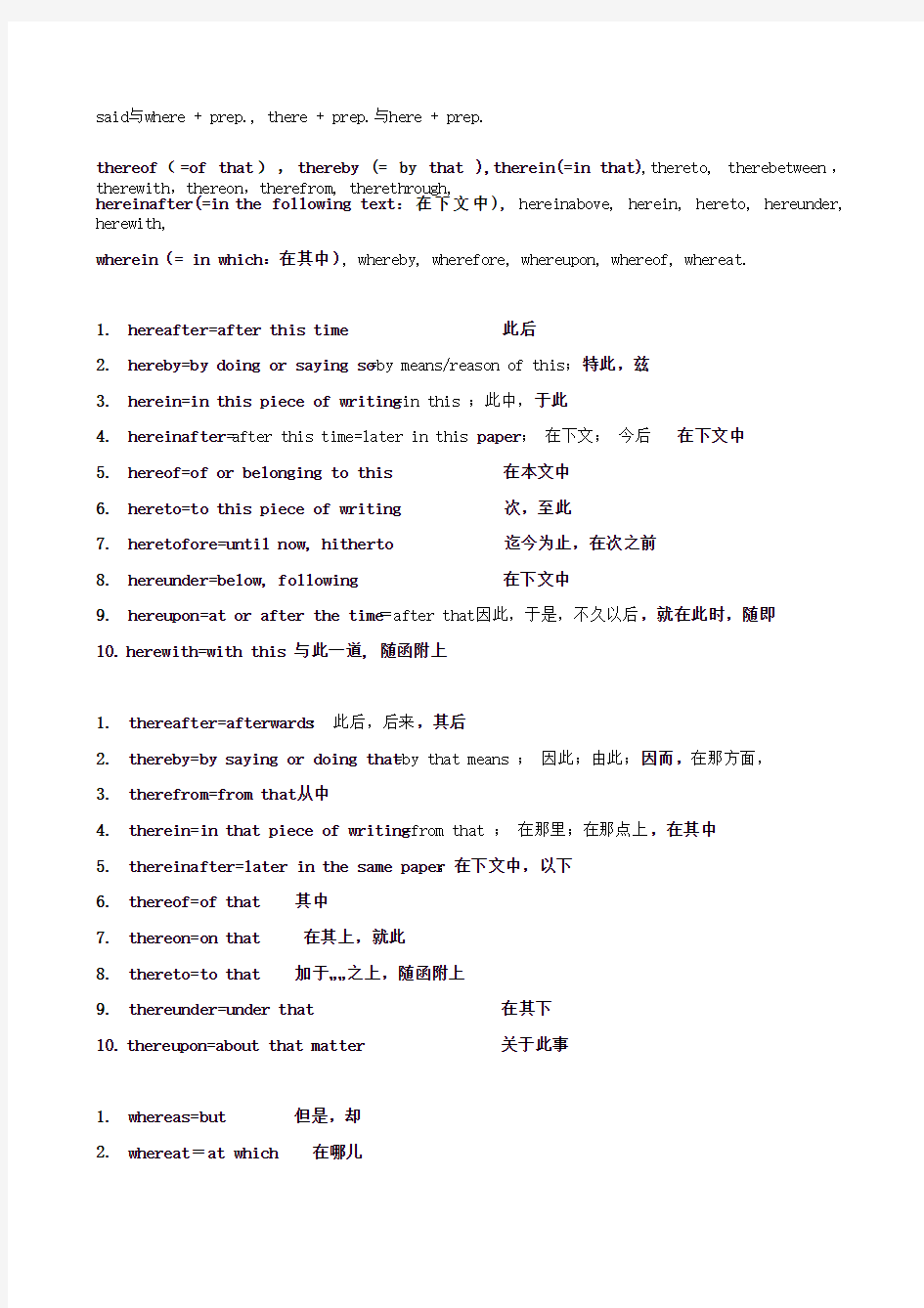专利术语


said与where + prep., there + prep.与here + prep.
thereof(=of that),thereby(=by that),therein(=in that),thereto,therebetween,therewith,thereon,therefrom, therethrough,
hereinafter(=in the following text:在下文中),hereinabove,herein,hereto,hereunder, herewith,
wherein(= in which:在其中), whereby, wherefore, whereupon, whereof, whereat.
1.hereafter=after this time 此后
2.hereby=by doing or saying so=by means/reason of this;特此,兹
3.herein=in this piece of writing=in this ;此中,于此
4.hereinafter=after this time=later in this paper; 在下文; 今后 在下文中
5.hereof=of or belonging to this 在本文中
6.hereto=to this piece of writing 次,至此
7.heretofore=until now, hitherto 迄今为止,在次之前
8.hereunder=below, following 在下文中
9.hereupon=at or after the time=after that因此,于是,不久以后,就在此时,随即
10.herewith=with this 与此一道, 随函附上
1.thereafter=afterwards; 此后,后来,其后
2.thereby=by saying or doing that=by that means ; 因此;由此;因而,在那方面,
3.therefrom=from that从中
4.therein=in that piece of writing=from that ; 在那里;在那点上,在其中
5.thereinafter=later in the same paper;在下文中,以下
6.thereof=of that 其中
7.thereon=on that 在其上,就此
8.thereto=to that 加于……之上,随函附上
9.thereunder=under that 在其下
10.thereupon=about that matter 关于此事
1.whereas=but 但是,却
2.whereat=at which 在哪儿
3.whereby=by means of which=by what ; by which; 由是;凭那个 以……方式
4.wherein=in which=in what;在哪里;在哪点上,在哪方面
5.whereof=of which 关于
6.whereto=to which 向哪里,到什么地方
(here =this,there=that,where =what/which)
专利专用语:发明专利:invention patent;实用新型专利:utility model patent;外观设计:design patent;权利要求,权项:Claims/(I)We claim/What is claimed is/What we claim is ;现有技术(现有专利、先有专利、在先专利、在先技术等):prior art;所属领域技术人员:those skilled in the art;(某某号某国专利,如)8544445号美国专利:US Pat.No.8544445:未决专利(正在申请中的专利):pending patent;实施方案/实施例:embodiment;优选/另一个(实施方案):preferred/alternative(不用carefully selected/another);(专利)公开:disclose(v.) /disclosure/publication (不用reveal等)。
②.装置与部件的指称用语:可根据具体情况从apparatus,arrangement,device,means中选用,前提是它们不是出现在同一篇说明书内。否则,装置:用apparatus或arrangement表示;器件:device ;构件:means,member或element(后两者尺寸相对较小)。众所周知,component本是准确表示部件或构件的词汇,但在专利说明书中反而很少使用,这是因为国外专利说明书是由律师撰写的,他们习惯于用某一概念的上位词来表示该概念(比如means、member所指意义显然比component广),企图籍此扩大专利的保护范围,国外专利界习惯于这种做法,但不符合中国知识产权局的规定([3]《审查指南》第125页) 。英译时,应参照英美等国专利说明书少量、慎用这种上位词,不要自创。
③.发明叙述过程常用普通词汇或词组:
(a).名词:壳体(外壳):housing,casing(不要用case,shell等);较大的或圆柱状开口(孔洞):opening;较小的孔径、孔洞:aperture,orifice;空隙、气孔:pore(很少用hole来表示孔洞,可能是表意不够细致、准确);
(b).形容词或相关词组:邻近、靠近:adjacent或adjoin(ing)(几乎不用neighbouring,close to或near等,可能是正式程度不高);许多、多个(可数)):a plurality of(该词组大量使用,而几乎不用many,a large number of等);弹性的(金属):resilient(不用flexible或elastic等);长形(构件):elongated (而不用long-shaped);
(c).动词:(数个部件的协同)合作:couple(vt.)(少用cooperate with,coordinate,combine, integrate等);(用某种力)将某部件拉住或压向…:urge;(安)装在…/设有…(带有表示位置的状语):to be disposed,to be mounted,to be installed,to be arranged,to be provided,to rest,to seat等。其中以to be disposed更为国外律师所青睐,使用频度更高。需要说明的是,如要强调安装的动作,必须使用install或mount,但在专利说明书中需要说明的往往是已安装部件的状况,所使用的被动语态中的过去分词强调的是安装动作已完成的结果,即结合安装位置的状语,实际上强调的是部件所安装的位置,因此不一定要使用动作性强的install等词),如表示部件装于孔洞内或下凹处,也可用to be received或to be contained;并置,比邻放置:juxtapose。学会使用这种词汇可使表达更简洁(例子见上小节);
(d).副词:以固定方式/以枢轴转动方式/以可拆卸方式/以(垂直/横向)移动方式/以可滑移方式/以转动方式/以密封方式(与……连接/(被)支承在……):(to be connected to…/to be supported on/in/at…)in a rigid/pivotal/detachable/(vertically/horizontally)movable/slidable/ rotatable/sealable manner,或to be rigidly/pivotally/detachably/ (vertically/horizontally)movably/slidably/rotatably/sealably(connected to…/supported on/in/at…)。(这些副词使用频度远比在一般科技资料中的高,成了专利说明书“招牌”用语);最好,最佳(表示选择)preferably。
④. 附图相关词汇:附图:accompanying drawing(s);视图:view;(插图顺序说明如)图1:FIG 1 (按美国专利法实施细则规定, 一篇专利说明书只有一个插图, 无须作任何标识,如有两个或两个以上,用FIG (大写)加阿拉伯数字来表示,同一个图有几个分图,则在阿拉伯数字后再加大写英文字母来表示(如FIG1A,FIG1B…;FIG2A,FIG2B…);正视图/側视图/左(右)视图/俯视图/底视图/后视图: front/ side/
left(right)/ top(overhead, aerial)/ bottom/ rear view ;截面图/透视图/示意图(原理图)/结构图/爆炸图(分解图、立体图)/ sectional/ perspective/ schematic/ structural /exploded view ;方框图 block diagram ;线路图wiring diagram。
1. 翻译时,应首先根据语法分析句子,然后才根据专业知识进行判断。
2. a, an 原则上不译出,即不说”一个/ 一”。除非为方便表达而需要:如:每一个,至少一个,另一个,时。
2a. 权利要求中的said一律译成“所述”,the一般也推荐译成“所述”。
2b. 说明书中的said一律译成“该”,the一般不译出,需要的话译成“该”。
3. 被动表达式原则上译成主动式。尽量直译,不要意译; 首次提到的部件最好放在句末。
4. 同一篇专利中单位是要统一,全字母/全中文
5. 连词“and”
and连接几个并列句时,有时表示并列或动作的先后顺序,不需要每个and都译出,最后一个and有时可译为“而”,如X is 1 and Y is 2.可译为“X为1,而Y为2。”;
在include…, …, … and …的句型中,一般and后为最后一个词,另外注意使用顿号;and连接两个组合词时,有时有些词省略了,如clone and expression vectors,这里and后的组合词一般为复数,如果译为“克隆和表达载体”容易让人误解为一种载体,应译为“克隆载体和表达载体”。
6. 较短的定语最后放在中心词之前。
7. 在A was (were) perpared … by doing…, doing …, and doing…的句型中,如果by doing…, doing …, and doing…不是很长的话,最好先译by…。另外注意几个doing是并列的。也可以译为“通过如下方式制备A: doing …, and doing…: ”
8. 注意and或or,它们连接的是并列的句子或并列的成份,连接的两个成份的词性应是相同的。
9. upon-很多时候相当于on。
10. 注意插入语,插入语往往由两个逗号分开,注意不要让插入语影响句子分析,应该将插入语两边的语法成分连起来看。
11. 长句子注意断句,中文的句子不要太长。
12. 注意使用 “因为(由于)…所以(因此)”、“虽然(尽管)…但(但是)”、“如果…那么(则)”等等,以使意思更加明确。
